
 |
NATURAL CURVES SURFBOARDS |
| Surfboards | | | Design | | | Surfing & Media | | | Surfcast | | | About NC | | | Custom Orders | | | Contact |
| Rail Anatomy 2023 version | Rail Anatomy 2012 version |
| |
SURFBOARD RAIL ANATOMY |
| |
|
| |
October 3, 2023 |
| |
|
| |
OVERVIEW
Rails are a critical component of every board. The configuration, volume, and features of rails - the profile, apex, tuck and edge, and volume determine how rails perform. The performance of a well designed rail for surfers, waves, and conditions offers acceleration, projection, planning speed, maneuverability, and control. Nuanced variations in rail features provides maximum performance features for various surfboard designs and classes. RAIL CONFIGURATIONS FEATURES Rail configuration is significant not only for it's features and the rail's performance, but also for and how seamless the rails perform in sync with the other variables of a board's design. |
| |
|
| |
 |
| |
|
| |
Full Rail Profile |
| |
|
| |
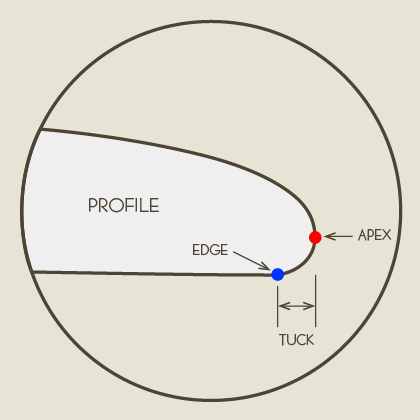 |
| |
|
| |
Rail Profile Zoomed in with Configuration Features |
| |
|
| |
PROFILE The profile of a rail is defined by the curve connecting the top
and bottom of a board. The apex or furthest point from the center of the board
in this curve determines the type or class of rail. Rail profiles vary from
nose to tail. Rails are foiled from the nose and entry, through the wide point
to the tail. Profiles are neutral in the nose, entry, and wide point and
develops a tucked corner and edge as it transitions from wide point to tail.
It's important to note that as a rail profile transitions or foils from nose to
tail the rail profile curve on the deck side of the rails maintains it's
profile and curve. The rail profile curve from the apex to the bottom changes
to develop the tuck and edge common and essential to rail and ultimately board
performance. The apex of rails in most surfboard classes and designs is at or
below center of a boards thickness. Common rail profiles as defined by their
apexes are a 50 / 50 rail profile, a 60 / 40 rail profile, and some lower rail
profiles depending on the performance requirements of a board. Prior to the
shortboard revolution of 1966 to 1969, classic LBs featured a neutral 50 / 50
rail profile. Early shortboards featured the same neutral rail profile. This
rail configuration featured stability and control, but failed to offer much
acceleration, planning speed, or maneuverability. The shortboard revolution
introduced a lower apex to rails. The down rail profile creates notably more
lift and less drag providing more acceleration, projection, planning speed, and
maneuverability with excellent stability, predictability, and control. The
development of the down rail profile by Mike Hynson improved surfboard
performance dramatically and was a quantum leap forward in surfboard design.
APEX The apex of a rail is the point on a rail where the profile transitions from the top or deck to the bottom of a board. It is the furthest point of a rail from the center of a board. The apex is higher on full boxy rails and lower on crowned rails. The apex of a rail remains constant in proportion to the rail foil from nose to tail to maintain uninterrupted laminar flow. The rail foil mimics and is in sync with a board's profile foil creating acceleration and control. TUCK and EDGE Tuck and edge are features that define the rail profile from the apex of the rail to the bottom of a board from nose to tail. Tuck is how far this curve goes into the bottom of the board. Generally, there is more tuck in the nose, entry, and wide point. Tuck decreases from wide point to tail. Edge is the transition from tucked rail to the bottom of a board. Edge is generally non existent in the nose, entry, and wide point. It starts to develop at the wide point and develops notably as the rail nears the tail. VOLUME Rail volume is a feature that with the other features of a rail determines how a rail enters, holds, and releases the water in the face of a wave when turning and planning. Higher volume rails require more force from a surfer for rails to enter and release water and perform maneuvers. Conversely, lower volume rails require less force from a surfer for rails to enter and release water and perform maneuvers. Too much rail volume and a board will keep a board high on the water, ok for speed, but lacking control on rail. Too little volume and a board will sit low in the water and when on rail will not have the buoyancy necessary to accelerate after engaging and releasing the rail. Correct rail volume with appropriate profile and well foiled from nose to tail, will engage the rail for stability and control and release the rail to accelerate out of turns, develop, sustain, and maintain speed in the various sections of a wave. DOWN RAILS All contemporary surfboard classes and designs feature a down rail profile with the exception of classic LBs and some retro designs. Rail profiles lower than a 50 / 50 profile are a down rail profile. The low apex of a down rail profile creates lift and reduces drag creating acceleration, projection, speed, and maneuverability. The deck side curves created by the rail's low apex hold the rail and board securely in the face of a wave with stability, predictability, and control through turns, speeding down the line rail to rail, or in trim. The bottom side of the rail with it's transition from soft moderate tuck with no edge in the nose, entry, and wide point to the reduced tuck and developing edge in the tail releases the rail. Specific down rail design features - profile, apex, tuck and edge, and volume - will vary and are tuned for surfer, board design, and wave size, quality, and conditions. PRIMARY RAIL PROFILES BOXY RAILS Fuller boxier rails are generally for boards that require more rail volume. Shorter boards for marginal waves, boards for heavy footed or bigger surfers, and boards requiring more stability. Note the higher apex and slightly deeper tuck of the boxy profile. |
| |
|
| |
 |
| |
|
| |
CROWNED RAILS Crowned, domed, or tapered rails are generally for boards that require less rail volume. Performance shortboards for quality waves, Step ups, Semi guns, boards for light footed or smaller surfers, and boards requiring maximum control. Note the lower apex and slightly shallower tuck of the crowned profile. |
| |
|
| |
 |
| |
|
| |
DESIGN SPECIFIC RAIL FEATURES
SHORTBOARD, STEP DOWN, and STEP UP RAILS Shortboard, Step Down, and Step Up rail profiles range from boxy to crowned. Rail volume is tuned to surfers and waves based on theories of volume and displacement. Tuck in the nose, entry, and wide point is neutral with no edge. Tuck from wide point to tail decreases notably to no tuck and hard edge in the tail. The neutral entry and wide point profile foils to minimum tuck and hard edge well forward from the tail on shortboards and step ups to maximize release and lift. The nuanced, balanced, and integrated rail profile, rail foil, and tuck and edge of shortboards and step ups fit naturally and comfortably in critical sections of waves creating acceleration, projection, planning speed, and maneuverability. SEMI GUN RAILS Semi Gun rail profiles are moderately crowned or low volume box. Rail volume is tuned to surfers and waves based on theories of volume and displacement. Tuck in the nose, entry, and wide point is neutral with no edge. Tuck from wide point to tail decreases gradually to minimum tuck and soft edge in the tail. The neutral entry and wide point rail profile foils to minimum tuck and soft edge at the tail in semi guns for release and control creating lift, acceleration, projection, planning speed, and maneuverability. XXL GUN RAILS XXL Guns feature a crowned deck or a flat deck for increased paddling power and stability in XXL waves and heavy water and a low chiseled rail profile and foil for performance and control. XXL Gun rails are tuned to surfer and XXL and heavy water waves. The rail profile is constant from wide point to tail, but the volume and thickness of the rail foils with the the profile foil of the board. Although crowned and tapered the rails of a gun must have significant volume to accomodate the speed and power in XXL waves and heavy water. The rail must support the forces of the wave and the surfer to control and maintain speed dropping into critical XXL waves and carving long turns on rail. Tuck in the nose, entry, and wide point is neutral with no edge. Tuck from wide point to tail decreases gradually to minimum tuck and soft edge in the tail. From wide point to tail the bottom of the rail profile transitions from a neutral tucked profile to a moderately tucked soft edge. At the fin the rail has some tuck to maintain maximum control and stability. The neutral entry and wide point rail foil with minimum tuck and soft edge in the tail is designed to control the speed and power of XXL waves and heavy water. MID LENGTH and EGG RAILS Mid Length and Egg rails are borrowed from the modern shortboard. The notable and substantial volume of Mid Length and Egg designs from their length, width, and thickness requires the rail profile to be a lower moderately thin boxy profile or lower crowned rail profile. The profile is round and neutral through the nose, entry, and widepoint allowing the rail to engage the face of waves as a board rolls onto the rail. The round, neutral rails in the entry and wide point provide easy transitions from rail to rail in critical tight sections of waves. Rail volume is tuned to surfers and waves. From the wide point to the tail the rail profile remains the same on the deck, but below the apex develops a tucked edge. At the fins the rail has minimum tuck and a moderately hard edge. The rail foil provides control and release creating acceleration, projection, planning speed, and manuverability. Mid Length and Egg rail profiles are sublime foils offering performance, planning speed, control, and stability. CONTEMPORARY LB RAILS Contemporary LB rails mimic shortboard, step up,semi gun, and mid length and egg rails. Contemporary LB rails feature the same sublime foils as mid length and eggs for performance generating acceleration, planning speed, control, and stability. Profiles range from full box to thin crown. Volume is tuned to surfers and waves. Rail volume also considers the size, technique, and style of the surfer and the dimensions and ultimately high volume of the modern contemporary LB. Tuck in the nose, entry, and wide point is neutral with no edge. Tuck from wide point to tail decreases to minimum tuck and soft edge in the tail. Like the rails on almost all designs and classes from shortboards to contemporary LBs these rail feature provide control and release creating acceleration, projection, planning speed, and manuverability. CLASSIC LB RAILS Classic LB rails are neutral from nose to tail. The profiles vary from 40 / 60, 50 / 50, to 60 / 40. The length, width, and ultimately high volume of a classic longboard, combined with the size, technique of the surfer, and deck design determine the volume of the rail. Rails tuck into the bottom from the apex from nose to tail. Tuck decreases slightly from wide point to tail. Classic LB rails have no edge. The neutral rails and apex nose to tail with with tuck and no edge are an essential feature of the glide, trim, and nose riding performance features of Classic LBs. RAIL PROFILE FOILS NOSE to TAIL Rail profiles transition or foil from nose to tail to create a rail that engages the water in a wave for stability and control, creates lift to maximize performance, and releases water from the board in the tail to eliminate drag and promote acceleration, projection, planning speed, and maneuverability. The neutral rail profile in entry and wide point features a seamless transition of the curve of the rail from the top to the bottom of the board. The curve of the rail meets the bottom of the board at one single point creating a seamless profile. This transition from the apex of the rail to the bottom of the board promotes notable lift from the bottom and maximum rail control. The reduced tuck and developing edge from the wide point to tail produce a cornered transition from the apex of the rail to the bottom of the board. The bottom and curve of the rail intersect at one point creating a cornered profile that promotes more lift than the lift at entry and wide point and maintains stability and control. Although reduced significantly the tuck nearing the tail continues to maintain stability and control. A soft or hard edge with little or no tuck in the tail releases water from the rail. This release is an essential performance feature reducing drag and promoting acceleration, projection, planning speed, and maneuverability. The nuanced nature of the transitions or foil nose to tail in rail profiles are essential to all performance features for all surfboard designs and classes. Rail profiles foil from neutral nose tucked with no edge, to wide point with hints of nuanced tuck and no edge, to tail with minimum tuck and maximum edge. The foil from neutral entry to firm tail varies by a board's design and range of conditions. Boards for smaller or marginal waves feature less tuck and more edge from wide point to the tail. Conversely, boards for critical, powerful, hollower, or bigger waves feature more tuck and less edge from wide point to tail. Rail profile foils will vary depending on a board's design. Neutral nose, entry, and wide point is common to nearly every design and surfboard class. Tuck and edge from wide point to tail varies notably from small and moderate wave designs to XXL wave designs. Tuck and edge vary across the entire range of designs and classes from performance shortboards to mid length fun boards to cruising LBs. DESIGN SPECIFIC RAIL PROFILE FOILS SHORTBOARD, STEP DOWN, and STEP UP RAILS Rail foil at nose, wide point, & tail designed to maximize performance features - acceleration, projection, and speed through turns, planning speed, maneuverability, predictability, control, and stability. The thinner neutral rail in entry and wide point allows the rail to engage the face of the wave. The developing tucked edge from wide point to tail creates lift. The tucked machined edge in the tail releases the rail. Note the apex and tuck in the nose, wide point, and tail. |
| |
|
| |
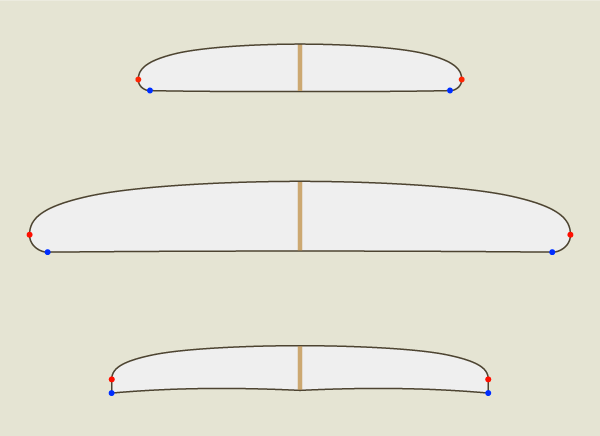 |
| |
|
| |
SEMI GUN RAILS Rail foil at nose, wide point, & tail featuring hidden foam on the deck side of the rail profile for paddling with a low apex for performance and control. Note the apex and tuck in the nose, wide point, and tail. |
| |
|
| |
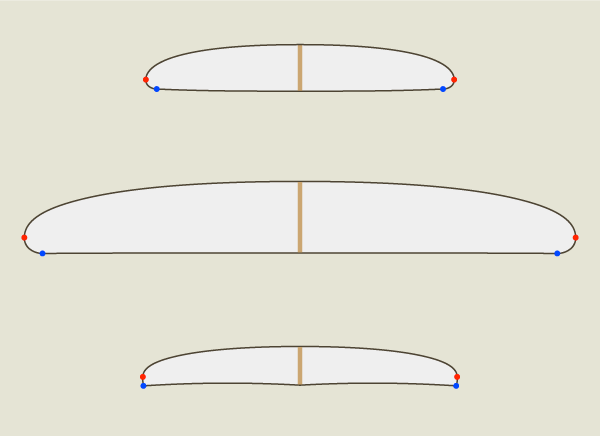 |
| |
|
| |
XXL GUN RAILS Rail profile at nose, wide point, & tail featuring a flat deck for paddle power and stability and low chiseled rail for performance and control. Note the apex and tuck in the nose, wide point, and tail. |
| |
|
| |
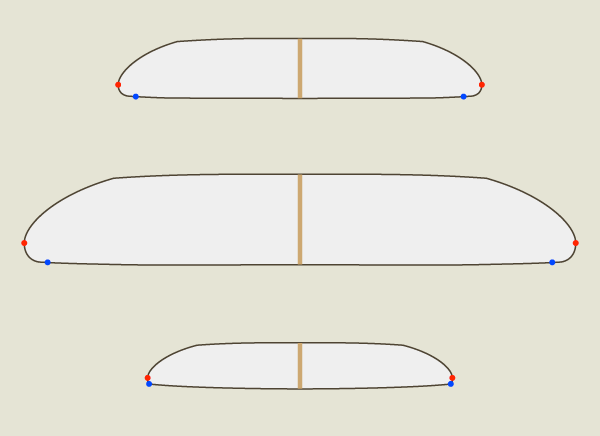 |
| |
|
| |
MID LENGTH and EGG RAILS Rail profile at nose, wide point, & tail featuring sublime foils for acceleration, projection, maneuverability, turning performance, planning speed, control, and stability. Note the apex and tuck in the nose, wide point, and tail. |
| |
|
| |
 |
| |
|
| |
CONTEMPORARY LB RAILS Rail profile at nose, wide point, & tail featuring the same sublime foils as the mid lengths and eggs for acceleration,projection, maneuverability, turning performance, planning speed, control, and stability. Note the apex and tuck in the nose, wide point, and tail. |
| |
|
| |
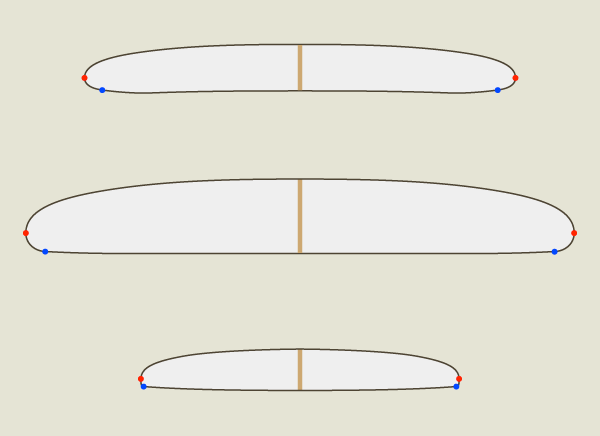 |
| |
|
| |
CLASSIC LB RAILS Rail profile at nose, wide point, & tail featuring classic 40 / 60 profile nose, 50 / 50 profile wide point, and 60 / 40 profile tail. The neutral rail with no tucked edge holds the Classic LB firmly in the face of a wave - a key design feature for nose riding. Note the apex and tuck in the nose, wide point, and tail. |
| |
|
| |
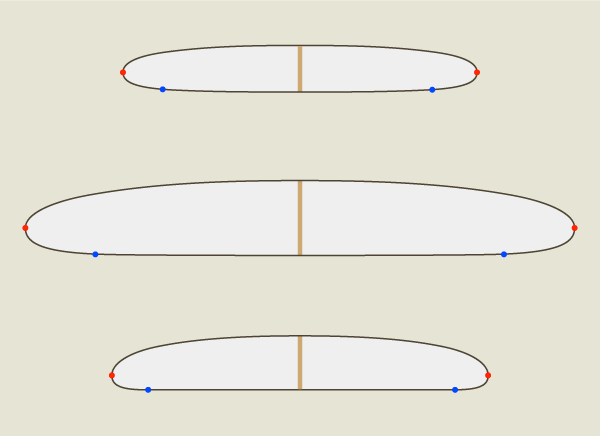
|
| |
|
| |
LINKS
Theory of Volume Theory of Displacement Tuning & Detuning Rails |
| |
< top of page > |
| |
|
| SURFBOARD RAIL ANATOMY | |
| |
|
| |
November 3, 2012 |
| |
|
|
OVERVIEW
Rails are the primary interface between surfboards and waves. The configuration and volume of rails facilitate acceleration, projection, speed, maneuverablity, and control. Like the other primary variables of surfboard design, rail designs will vary according to the design goals of every surfer and the various wave they ride. Rail design is a function of the physical features and technique of a surfer, the various waves they ride, and the other design variables and features incorporated in each surfboard. RAIL CONFIGURATION is significant as it functions to integrate and synchronize rails with the other variables included in the design of a surfboard. Boxier rail profiles are generally used in shorter boards or boards designed for surfers who displace more water with their technique. Crowned, domed, or tapered rail profiles are generally used in boards to control volume or for surfers who displace less water with their technique. RAIL VOLUME is significant as it allows a surfer to engage or place the rail of a board in the face of a wave when initiating turns and support the dynamic displacement of a board by a surfer through the turns and maneuvers they perform. Rail volume and the other rail features determines how a rail engages, holds, and releases a board in the face of a wave. A rail with too much volume won't engage and control the rail and board in the face of a wave. A rail without enough volume won't have enough buoyancy to release, accelerate and project out of turns. A rail with correct volume will engage and control the board in the face of a wave and release the rail with acceleration, projection, and speed out of turns. |
| |
|
|
PRIMARY RAIL CONFIGURATIONS
DOWN RAILS All contemporary surfboard classes and designs feature a down rail profile with the exception of classic LBs and some retro designs. Rail profiles lower than a 50 / 50 profile are a down rail profile. The low apex of a down rail profile creates lift and reduces drag creating acceleration, projection, speed, and maneuverability. The deck side curves created by the rail's low apex hold the rail and board securely in the face of a wave with stability, predictability, and control through turns, speeding down the line rail to rail, or in trim. The bottom side of the rail with it's transition from soft moderate tuck with no edge in the nose, entry, and wide point to the reduced tuck and developing edge in the tail releases the rail. Specific down rail design features - profile, apex, tuck and edge, and volume - will vary and are tuned for surfer, board design, and wave size, quality, and conditions. |
| |
|
| BOXY RAILS are a full round rail. Boxy rails will vary in volume with the overall thickness of a surfboard. The top of a boxy rail will flow out of a relatively flat or very moderately crowned deck. This rail configuration is generally used in shorter boards or boards designed for surfers who displace more water with their technique. |
 |
| CROWNED RAILS are a low tapered rail. Crowned rails blend well with a moderately crowned deck. This rail configuration is generally used in step up shortboards, semi guns, XXL guns, and mid length and eggs, for maneuverability and control of the volume in these designs. Crowned or domed rails perform well in any design for surfers who displace less water with their technique. |
 |
| |
|
|
Shortboards, semi guns, XXL guns, mid lengths and eggs, and contemporary
longboards feature some variation of these fundamental rail configurations. The
bottom half of the rail configurations in these design will generally be
moderately tucked and softer in the nose, entry, and wide point and become
harder and less tucked as they progress to the fins and tail of the board. The
lower profile and changing configuration of the bottom half of boxy and crowned
rails distinguises itself from the 50 / 50 rails common to the classic
longboards and the displacement hulls that preceeded the extremely speedy and
maneuverable modern surfboard.
Surfers and shapers will use their knowledge and experience to design and shape appropriate rails for a wide variety of surfboard designs and the additional design variations in the context of those designs. |
| |
|
|
DESIGN SPECIFIC RAILS
SHORTBOARD RAILS are round an neutral in the nose, entry, and widepoint. The rail foil or profile mimics the foil or profile of the body of the board. The bottom of the rail develops a firm corner with the tuck decreasing as it transitions from the wide point to the tail. The rails have a very hard - crisp edge from the leading edge of the rail fins through the tail. Thinner boards have a fuller profile on the deck side and thinner boards a moderately lower profile. The volume of the rail is thin enough to provide control and full enough to support the surfer on rail during turns and maneuvers. Generally, the rail configuration and volume of step down boards will be moderately fuller and the configuration and volume of step up boards moderately leaner than the the rail configuration and volume of a pure shortboard. SEMI GUN RAILS have a moderately crowned configuration or profile. They are round and neutral in the nose, entry, and widepoint and develop a firm corner as they transition from the wide point to the tail. The hard edge in the tail is watered down a little compareed to the edge in the tail of a shortboard for greater control in heavy water at high speed. Rail profiles are generally lower than those of the shortboard for control and stability in thick heavy water waves at high speed. Control and stability are essential in semi guns. For control thicker higher volume semi guns feature a lower rail profile. Conversely, for stability thinner lower volume semi guns feature a moderately fuller profile. XXL GUN RAILS are neutral and forgiving in the entry. They transition from this neutral entry into a steep, crowned, angular profile in the wide point that tucks softly into the bottom of the board. The rail profile remains the same from the entry to the wide point and through the tail. The volume of the rail corresponds with the foil of the profile of the board. Although crowned and tapered the rails of an XXL gun must have significant volume to accomodate the speed and power involved in XXL waves and heavy water. The rail must support the forces of the surfer and the wave for control and stability and maintain speed while the board is on rail. From the wide point to the tail the bottom of the rail profile transitions from a neutral tucked profile to a moderately tucked soft edge. In the tail the XXL gun rail has more tuck and less edge to maintain maximum control and stability. MID LENGTH and EGG RAILS are borrowed from the modern shortboard. They feature a boxy or crowned rail profile - round and neutral through the nose, entry, and widepoint allowing the rail to engage the face of a wave as the board rolls onto the rail. The round, neutral rails in the entry also provide easy transition from rail to rail in critical sections of waves. From the wide point to the tail the rail profile remains the same on the deck, but begins to shorten the radius and develop a tucked edge on the bottom of the rail. In the tail the rail has minimum tuck and hard edge. This transition provides the rail foil with controlled lift and release so the board can accelerate off the rail and out of turns. The notable and substantial volume of Mid Length and Egg designs requires the rail profile to be a lower moderately thin boxy profile or a crowned rail profile. CONTEMPORARY LONGBOARD RAILS mimic shortboard, mid length, and egg rails. The length, width, and thickness and the ultimately high volume of the modern longboard combined with the size and technique of the surfer determine the required configuration and volume of the rail for best performance. CLASSIC LB RAILS feature neutral rail profiles with classic 40 / 60 profile nose, 50 / 50 profile wide point, and 60 / 40 profile tail. The neutral rail with no tucked edge holds the Classic LB firmly in the face of a wave - a key design feature for trim and nose riding. |
| |
|
| |
< top of page > |